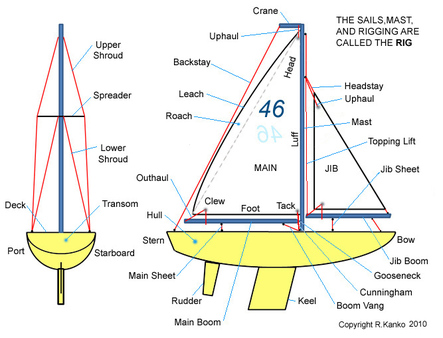Introduction
This site is all about the physics of sailing, though it focuses less on the stereotypical fluid dynamics of sails and more on the different types of ships and how the physics is slightly altered for each.
Sailing Terms
- Mast: The tall, vertical pole that supports the sails; this is usually a stationary, fixed point on the ship.
- Hull: the body of the boat. Some sailboats, like catamarans and trimarans, have two or three hulls, respectively, but the traditional sailboats only have one.
- Keel (centerboard): the vertical underwater portion of the boat that helps keep it upright in the water, among other things. See Physics of Motion for more information.
- Sail: This is the 'wing' of the sailboat; it is traditionally made of canvas and there are many different types, though we will focus on only two here.
2) Jib/headsail: this is the (usually) smaller front sail
- True vs. apparent wind: True wind is the wind the ship feels when it is standing still and the one that gives the ship the initial push towards movement; apparent wind is the wind the ship feels because it is moving. It’s like the wind you feel when you are standing by the ocean versus the ‘wind’ you feel when you are running.
- Lee: This is a term associated with the direction the wind is blowing; if the wind is blowing towards this shore (or if the boat is moving sideways in this direction), then it is the lee side or lee shore. Conversely, the side the wind is coming from is the windward side.
- Heeling: This is when the forces acting parallel to the surface of the water push the boat into a controlled lean. This is a normal part of sailing and happens any time the ship is moving relatively quickly.
- Capsize: Not to be confused with heeling, this is the action of the boat tipping over to such a degree that it can no longer sail and falls into the water; in some cases it can flip over completely.
- Cap
|
There are different angles you can sail in relation to the wind and each has a different name for reference. The only ones discussed on this site are close reaching and running, but it should be noted that the physics changes slightly for each angle and that sailing is not possible in the dead-zone directly facing the wind, called 'in irons'. |
Stacey Krepel
Physics 212 F07
Spring 2014
Physics 212 F07
Spring 2014

